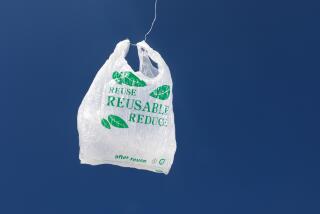ZAP! : Today’s Plastic Bags Offer Capabilities Far Beyond Simple Storage
- Share via
Despite their relatively short existence, plastic bags have become a staple in most American households. From the pioneer sandwich and food storage bags introduced in the early 1960s, annual sales have grown to $1.5 billion, according to Marlin Stover, manager of marketing services for Glad Bags.
Bags have also undergone many changes during this period. Today there are not only those intended for refrigerator storage, but modified products have been designed for freezer storage, as well as cooking in the conventional oven, microwave and boiling on top of the range. In an even more recent development, some bags can be used for blanching food in the microwave oven before freezing.
Bags are made of different materials, so it’s important to read labels and use them only for the purposes for which they were intended. The Times compiled the following information on three multi-use plastic bags.
Daisy Seal-a-Meal bags are a lamination of polyester and polyethylene. They are available at discount department stores in 1/2 pint, pint and quart sizes, as well as continuous rolls of 8- and 10-inch widths. The rolls enable the user to determine the second dimension of the bags.
A Daisy Seal-A-Meal system is needed to close the bags. This is a small electric appliance that uses heat to create the seal. Three models are available with the top of the line style having vacuum sealing capabilities. The manufacturer claims vacuum sealing decreases cooking time by one-third to one-half and increases frozen storage life.
Recommended uses for the bags include refrigerator and freezer storage, cooking in microwave ovens and top of range boiling. The bags should be punctured three or four times before microwaving to allow steam to escape. They should not be punctured before being dropped into boiling water and never boiled for more than 30 minutes.
The manufacturer also recommends the bags for blanching foods in the microwave oven before freezing. The Times’ Test Kitchen attempted to follow their directions, which instruct you seal the bag and microwave on HIGH 1 minute, rest 1 minute and then proceed to microwave an additional 30 seconds. In both tests pressure in the bag caused it to break before the first 1 minute of cooking had elapsed.
Dow Ziplock Microwave Bags have three layers of nylon and polyethylene. They have a split bottom designed to lie flat for storage. The bags are available in pint and quart sizes at local supermarkets. The zipper top is closed with the fingers--no additional equipment is needed for sealing. Some excess air may be extracted manually, but the bags are not vacuum sealed.
As the name implies, the manufacturer recommends using the bags for cooking in microwave ovens. They can be used for top of range boiling, but the zipper opening must be kept upright to prevent opening and the bag should not be punctured.
Dow also recommends their bags for blanching vegetables before freezing. The company worked with Cornell University in developing optimum times for specific amounts of different vegetables that ensure the enzymes causing undesirable flavor, color and aroma changes are inactivated.
They cite the advantage of blanching small batches of vegetables directly in freezer storage bags, thus eliminating the need for the large, more traditional equipment. A shallow bowl of ice water is used for cooling the blanched packets. The small amount of water added to the bags with the vegetables forms visible ice crystals inside the finished package, but the university study showed that these had no adverse effect on the end product.
After viewing a demonstration by the manufacturer, The Times’ Test Kitchen used the bags as directed. We had successful results following their instructions for blanching and freezing. After several weeks the vegetables had retained their color.
On the first test, we did have trouble with the ziplock seal tearing away from the bags when they were opened. We contacted the company and learned one code number of pint-size bags had been defective. They replaced the bags and a second test on both pint- and quart-sized bags proved entirely successful.
For a free brochure featuring a microwave blanching chart and recipes, call the Dow Consumer Products, Inc., toll-free number (800) 428-4795 or send a stamped, self-addressed envelope to Microwave Blanching, P.O. Box 68511, Indianapolis, Ind. 46268.
Reynolds Oven Cooking Bags are a nylon film, available in three sizes--regular (16x10-inches), large (20x14-inches) and turkey (23 1/2x19-inches). The nylon tie included in the package is used for closing. The bags are sold in local supermarkets.
These are the only bags designed for use in conventional ovens. Reynolds also recommends them for cooking in microwave ovens. The bags may be used for short-term refrigerator and freezer storage, but are not recommended for top of range boiling or blanching.
The manufacturer gives some safety measures to be followed when using the product. Before placing any food in the bag, always add 1 tablespoon of flour and shake to coat the inside and protect against bursting. Use a 2-inch deep supporting pan. Conventional ovens must be preheated before the bags are placed inside. This is because in many ovens both the broil and bake elements are activated to preheat the oven quickly and this extreme high heat can damage the bag.
The manufacturer points out the following advantages of using the bags:
--Eliminates oven cleanup, juices stay inside the bag and don’t splatter oven walls.
--Shortens cooking time in conventional oven up to one-third the time.
--Helps retain natural flavor and juices while assuring moist, tender food.
--The bags double as a container for marinating, freezing up to 1 month and refrigerator storage. Then foods are cooked in the same bags.
More to Read
Eat your way across L.A.
Get our weekly Tasting Notes newsletter for reviews, news and more.
You may occasionally receive promotional content from the Los Angeles Times.










